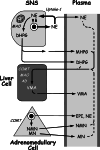Clinical catecholamine neurochemistry: a legacy of Julius Axelrod
- PMID: 16871444
- PMCID: PMC11520759
- DOI: 10.1007/s10571-006-9041-0
Clinical catecholamine neurochemistry: a legacy of Julius Axelrod
Abstract
1. Discoveries, insights, and concepts that Julius Axelrod introduced about the disposition and metabolism of catecholamines provided the scientific basis and spurred the development of clinical catecholamine neurochemistry. 2. Here, we provide examples of this aspect of Axelrod's scientific legacy.
Figures


References
-
- Axelrod, J., and Tomchick, R. (1958). Enzymatic O-methylation of epinephrine and other catecholamines. J. Biol. Chem.233:702–705. - PubMed
-
- Axelrod, J., Whitby, L. G., and Hertting, G. (1961). Effect of psychotrophic drugs on the uptake of 3H-noradrenaline by tissues. Science133:383–384. - PubMed
-
- Baas, H., Beiske, A. G., Ghika, J., Jackson, M., Oertel, W. H., Poewe, W., and Ransmayr, G. (1998). Catechol-O-methyltransferase inhibition with tolcapone reduces the “wearing off” phenomenon and levodopa requirements in fluctuating parkinsonian patients. Neurology50:S46–S53. - PubMed
-
- Bornstein, S., Breidert, M., Ehrhart-Bornstein, M., Kloos, B., and Scherbaum, W. (1995). Plasma catecholamines in patients with Addison's disease. Clin. Endocrinol.42:215–218. - PubMed
Publication types
MeSH terms
Substances
LinkOut - more resources
Full Text Sources

